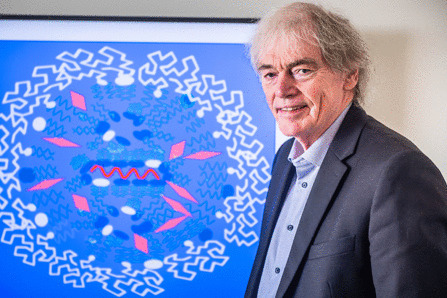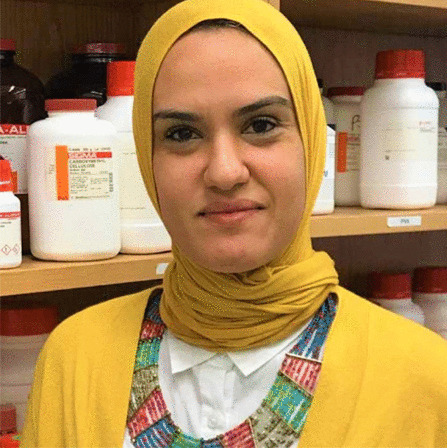Abstract
The triumphant success of mRNA vaccines is a testimony to the important role drug delivery technologies have played in protecting billions of people against SARS-CoV-2 (or the Corona Virus Disease 2019; COVID-19). Several lipid nanoparticle (LNP) mRNA vaccines were developed and have been instrumental in preventing the disease by boosting the immune system against the pathogen, SARS-CoV-2. These vaccines have been built on decades of scientific research in drug delivery of mRNA, vaccines, and other biologicals. In this manuscript, several leading and emerging scientists in the field of drug delivery share their perspective on the role of drug delivery technologies in developing safe and efficacious vaccines, in a roundtable discussion. The authors also discussed their viewpoint on the current challenges, and the key research questions that should drive this important area of research.
Keywords: COVID-19 vaccine, Drug delivery, Lipid nanoparticles, Polymeric formulations, Microneedles
Introduction
Since December 2019, the severe acute respiratory syndrome coronavirus 2 (SARS-CoV-2) outbreak has threatened the human population globally as the numbers of confirmed cases, hospitalized patients, and related deaths are continuously increasing. The World Health Organization (WHO) declared COVID-19 a pandemic on 12 March 2020. There have been efforts to develop therapies against COVID-19. However, prevention is a more effective paradigm in combating a global pandemic. Thus, this fast-spreading pandemic and global urgency required the development of potential vaccines at a breakneck pace. Several vaccines were developed and given emergency use approval by the United States Food and Drug Administration (US-FDA). Among these, were two highly novel types of messenger RNA (mRNA) vaccines from Moderna on the one hand and BioNTech/ Pfizer on the other. Unlike conventional vaccines that deliver attenuated virus or viral components, these mRNA vaccines utilised the human body’s own transcription machinery to in-situ synthesize the antigen by delivering an mRNA that specifically encodes a non-pathogenic viral component (most often the spike protein).
These new vaccines were made possible by the extensive research over the last decades into mRNA-based therapies and drug delivery technologies to efficiently deliver mRNA into the body. Lipid nanoparticles (LNPs) were found most successful drug delivery technology due to their high efficacy and safety [1–3]. The emergency approval of LNP encapsulated mRNA vaccines from Moderna and BioNTech/Pfizer has brought the field of drug delivery into the limelight as the mRNA vaccines are enabled by the LNP carrier. These recent developments have emphasized the importance of developing a drug delivery system as a central part of the drug development process, which has not been the case historically. The accelerated advances into drug delivery technology as a result of the historical FDA approval of the LNP encapsulated mRNA vaccines for COVID-19 will enable the future development of a broad spectrum of mRNA-based drugs ranging from cancer vaccines to preventive and therapeutic gene editing and gene expression.
Thousands of dedicated drug delivery scientists across the globe are now working to develop safer and more effective vaccines against the new variants of SARS-CoV-2 and develop new carriers and drug delivery strategies for future fights against new viral pathogens. In this manuscript, a group of leading drug delivery scientists share perspectives on drug delivery strategies that have helped save lives and new strategies that are currently under development, as well as challenges and future opportunities for managing future pandemics. They are also highlighting on-going research projects, as well as important research questions related to drug delivery technologies that involve LNPs, polymer nanoparticles, and microneedle patches that should be the focus in the future. This perspective reflects the opinions of some of the leading drug delivery scientists, who are the pioneers in vaccine delivery technology.
All authors agreed that drug delivery systems are key to effective mRNA-based vaccines. These complex, large molecules, mRNAs, cannot penetrate into cells on their own and are quickly degraded in biological fluids. The big breakthrough that LNP technology has enabled is efficient mRNA delivery into the cells and into the cytoplasm so that mRNA can be transcribed by the ribosomes to produce the required protein. The combination of strengths between the nucleic acid and drug delivery fields is the key for the development of safe and efficacious vaccines that can be administered to so many patients [1–3]. The complementary approach of drug delivery and nanotechnology has therefore been crucial for developing COVID-19 vaccines.
Drug delivery technologies being developed or have been developed for COVID-19 vaccine delivery
The laboratory of Prof. Langer (at Massachusetts Institute of Technology) has always done more basic research rather than that aimed at specific products. It goes back almost 50 years, and at the time, one of the challenges that they began working on was how to encapsulate big macromolecules, including nucleic acids, into nanoparticles. The project aim was to develop systems to administer angiogenesis inhibitors to rabbit eyes in collaboration with Judah Folkman. In 1976, they published a paper in the journal Nature showing that they could deliver almost any size molecule, which could be a protein or enzyme, an angiogenesis inhibitor, peptide, and nucleic acids, such as DNA and/or RNA [4]. They have continued to do basic work and they were one of the early labs, among others, to prolong the lifetime of nanoparticles in the body by using polyethylene glycol (PEG) [5–7]. They also published fundamental research on creating different lipid libraries for LNPs [8, 9], and, finally, they have been working on new manufacturing procedures for developing the nanoparticles [10–12]. Nevertheless, they started several highly focused companies for driving products out, such as Alnylam and Moderna.
The current mRNA vaccine LNP delivery technology stems from work done by the team of Prof. Cullis (University of British Columbia) and colleagues at companies he co-founded such as Inex and subsequently Acuitas Therapeutics. They started with siRNA, small interfering RNA, which is considerably smaller than mRNA but still a large molecule with molecular weight 13–17 kDa [13–20]. By developing and optimizing the ionizable cationic lipid components in LNP, they successfully delivered siRNA to the liver and to hepatocytes to silence a marker gene, clotting factor FVII, very efficiently [13, 21]. This resulted in an LNP siRNA drug called Onpattro to silence transthyretin in the liver to treat the hereditary disease transthyretin-induced amyloidosis that was approved by the FDA in 2018 [22]. Starting in 2012, related ionizable cationic lipid LNP technology was then optimized by Acuitas to deliver much larger mRNAs to express a marker protein, luciferase, in the liver [23]. Then, in collaboration with Drew Weissman at the University of Pennsylvania, they applied this technology for vaccine delivery. This collaboration led to positive results for influenza [24] and Zika [25] vaccines and demonstrated that this technology can enable mRNA to be used as a highly potent vaccine [26]. Shortly after, Acuitas started to work with BioNtech on influenza vaccines. BioNtech was also working with Pfizer to develop a flu vaccine. This combined expertise was translated into developing the COVID-19 vaccine, which incorporates an LNP developed by Acuitas, when the pandemic started.
Beyond this long track of outstanding research on LNP technologies, emerging leaders in the field have worked on polymer-based RNA formulations, e.g. Prof. Merkel [27, 28]. Specifically, Prof. Merkel's team at Ludwig Maximilian University has been focusing on developing polycations that are alternatives to polyethylenimine. Spermines are short endogenous polyamines that effectively condense DNA, particularly in sperm but also every other human cell. They reported that spermines, due to their small molecular weight, do not efficiently complex rigid, double-stranded siRNA. In 2014, they showed that increasing the length and thus the molecular weight of oligospermines improved the condensation and delivery of RNA. Since then, they have been employing different polymer chemistry approaches to polymerize spermines and make them biodegradable [29]. The group has additionally focused on spray-drying RNA nanoparticles for enhanced storage and transport conditions and has developed dry powders for inhalation delivery [30].
A different and promising approach has been the one pioneered by Prof. Prausnitz's team. He has developed microneedles for vaccine delivery [31]. The merits of this new technology have been demonstrated through many studies by his group at Georgia Institute of Technology as well as others, with a recent interest in the delivery of COVID-19 vaccines [32, 33]. From a logistical point of view, delivering vaccines by microneedle patches is easy and does not require the expertise of a healthcare professional in giving it as an injection, could be transported without refrigeration or at least reduced refrigeration, and does not generate sharps waste. This, in turn, can enable quick and massive immunization which is beneficial in pandemic situations similar to the COVID-19 scenario.
These kinds of logistical advantages have motivated the development of microneedle patches for annual influenza vaccination campaigns and also for distributing measles and rubella vaccines to remote locations. In this context, it is important to highlight that the skin is a particularly immunogenically active organ. Indeed, Prausnitz and others have shown a number of times that intradermal vaccination leads to a much better immune response than the classical intramuscular vaccination [34–36]. The simple explanation for this is that the skin is the body’s first defense barrier against outside pathogens, so it is well equipped with an innate and an acquired immune mechanism to fight those exogenous intruders. This is facilitated by the abundance of Langerhans cell in the epidermis and antigen-presenting dendritic cells in the papillary dermis in addition to the presence of multiple plexus systems in the dermal lymphatic system that transports both the vaccine and the antigen-presenting cells to the regional lymph nodes eliciting an immune response [37].
Given that, a fraction of the vaccine dose delivered intradermally by a microneedle patch can be equally immunogenic or even better compared to a full dose given by an intramuscular or a subcutaneous route. This is known as dose-sparing and has been evident in many preclinical and clinical studies [38–40]. Reduced doses could be beneficial to immunization programmes by making limited vaccine supplies available to larger numbers of people, and potentially reducing the costs of the vaccine and associated distribution and storage logistics. Interestingly, a research group in The Netherlands has recently published a study showing that an intradermal fractional dose regimen (1/10 or 1/5 of the dose) of the Moderna mRNA COVID-19 vaccine is well tolerated and safe, and most importantly capable of inducing robust antibody responses in vaccine recipients similar to a full dose given by intramuscular injection (100 ug) [41]. These results are very exciting as they imply that microneedle patches can be a simple, versatile and painless way for COVID-19 vaccine intradermal delivery. Further studies are needed to confirm safety and efficacy.
In terms of ongoing research involving microneedle-based delivery of COVID-19 vaccines, the group of Prausnitz has another project with collaborators at Emory University, where they are combining the use of microneedles with electroporation for effective delivery of a DNA vaccine [42]. Notably, DNA vaccines have difficulty being effective, particularly in humans. An additional approach that has been effective in many cases is the use of electroporation [43], but the approach can be cumbersome as it involves an injection of the DNA and then application of skin electrodes and a large electroporation device. Therefore, they have joined forces with a collaborator to build a very simple electroporator based on the piezoelectric element found in disposable BBQ lighters coupled with a microneedle electrode array, which could provide an inexpensive way to do mass vaccinations with electroporation-based DNA vaccines. This was applied for a COVID DNA vaccine, and could be used for mRNA vaccination as well.
Key design aspects of drug delivery systems for COVID-19 vaccine
Langer and Cullis have significantly contributed to the development of LNPs for encapsulation nucleic acid over more than 50 years that resulted in mRNA COVID-19 vaccine. The key motivation behind encapsulation of nucleic acids into LNPs was to optimize their stability and avoid their degradation. Optimization involved several design aspects.
Cullis first worked on optimizing the lipid composition. Back in the late 1990s, the only way of getting high encapsulation efficiencies of a nucleic acid-based drug in a lipid-based nanoparticle delivery system was to include permanently positive charged lipids in the nanoparticle formulation to associate with the negative charge on the interface of nucleic acids [44, 45]. However, these permanently positively charged lipids were found to be toxic. This initiated the idea to use ionizable cationic lipids which are lipids that have primary, secondary or tertiary amino functional groups and will be protonated at acidic pH to become positively charged. The team of Cullis achieved encapsulation of nucleic acids at pH 4 during the preparation stage, where all these lipids are positively charged. On increasing the pH of the dispersion to a neutral pH, the encapsulated nucleic acids were retained inside the nanoparticles [46, 47].
They also discovered that the ionizable lipids play a role in the ability to escape from the endosomes once they are taken up into a cell [20]. Optimization has therefore taken place to develop better ionizable lipids that not only allow high encapsulation of nucleic acids but also facilitate the escape from the endosome. And the hypothesis that continues to guide their efforts is that when nanoparticles are taken up by endocytosis, the pH of the endosome decreases as the endosome matures and the ionizable lipids will move from being neutral to being positively charged. Positively charged lipids will then interact with the negatively charged lipids of the endosomes resulting in a membrane lytic event, allowing the escape from the endosome. Ionizable cationic lipids have therefore led to significant progress in terms of achieving systems that are both relatively non-toxic, with high encapsulation efficiency, and efficient in delivering the encapsulated material to the interiors of the target cells. Microfluidic mixing technologies were also employed [48, 49].
Extensive work was also done by the group of Langer to develop lipid libraries to optimize the stability and encapsulation of DNA and RNA [8, 9], to manufacture LNPs via microfluidics [10–12], as well as to develop targeted nanoparticles together with Alnylam. More recently, the COVID-19 vaccine-related work was done by the Moderna scientists who have created lipid libraries and found out which lipid combination has the best properties in terms of efficacy, safety, and shelf life [12, 50, 51].
Many authors have optimized nanoparticle coating with PEG [5, 6, 52, 53]. PEG-lipids were found as an essential component of the lipid delivery system. PEG is generally regarded as safe and is used in a large number of therapeutics to achieve long circulation times. This is a technology that is well understood and used a lot for therapeutics [7]. However, there has been a discussion as to whether PEG is causing the few instances of anaphylactic reactions that have been observed with both the Moderna and the BioNTech/Pfizer COVID-19 vaccines. So far, the answer is not yet clear. There are current attempts to use PEG substitutes. The approach by Cullis and others has been to use a PEG that diffuses away from the surface of the LNP relatively rapidly. Systems that are being used therapeutically contain sheddable PEG. An important question for the next generation of LNPs is whether optimization of fast-shedding PEG will result in different outcomes.
Furthermore, Prausnitz regards one of the current needs for COVID-19 pandemic as the requirement to make a lot of vaccine doses and distribute them to billions of people quickly using resources available in the relatively near future. To meet these needs, he highlighted important research questions that need to be addressed to design a microneedle patch for mRNA LNPs delivery. This involves developing a formulation that can withstand the conditions of microneedle patch manufacturing including the drying process. When these dried microneedles are inserted in the skin, they should then be reconstituted in the interstitial fluids with the LNPs, and the mRNA encapsulated within, still intact. An additional constraint is that the drying method has to be compatible with the microneedle patch fabrication. A fluffy, lyophilised powder that is normally produced by freeze-drying of the mRNA encapsulated LNPs is not favorable in this case. This is because densely packed microneedles with no air voids are needed for effective skin insertions and hence delivery. Another challenge is the small volume of microneedles, so research attempts are needed to limit the ratio of excipients to active.
On the other hand, Merkel who is focusing on developing polymer nanoparticles and nanocomplexes for RNA delivery regards biocompatibility as a bottleneck in RNA delivery. Indeed, polymer nanoparticles involve the use of positively-charged polymers to pre-condense the nucleic acid, which makes approval by the regulatory bodies difficult. For this reason, at this point, using LNPs is advantageous for fast development of vaccines as compared to the polymeric materials that are currently under investigation. Nevertheless, the team of Merkel and others are currently attempting to develop advanced polymers for the aim of improving the biocompatibility of polymeric nanoparticles. They hope polymer nanoparticles might offer a significant advantage over LNPs for pulmonary administration and in regard to overall RNA loading.
Impact of vaccine delivery technologies on the long-term efficacy and safety profiles of current/future COVID-19 vaccines
Langer and Merkel have first highlighted the high efficacy and the safety of the available LNP technology for vaccination against COVID-19 based on several studies and available clinical data. The lipid technology used is now established and the composition of lipids integral to these profiles is known, mainly ionisable lipids and PEG-lipids. There was some concern about the anaphylactic reactions due to antibodies against PEG. However, rare reactions have been reported to COVID-19 vaccines. Nevertheless, for the future development of mRNA vaccines, researchers will initially rely on approved formulations and then further optimize them. Moreover, it will now be easier to conduct clinical trials with a different mRNA vaccine formulated with LNPs based on the current knowledge of the safety and efficacy of this type of delivery system. For further optimization, Cullis added that it is an important consideration to obtain a large therapeutic index during early evaluation stages in animal models. This is because the therapeutic index is expected to decrease moving from small animal models to non-human primates and to humans. Finally, Merkel pointed out that since booster doses may be needed due to the high mutation rate of the virus, there is a concern about using viral vectors instead of lipid- or polymer-based delivery systems because our immune system could recognize these viral vectors and then neutralize them before they can have an effect. This is less of a concern for the mRNA vaccines using LNPs.
On the other hand, the microneedle patch vaccination approach can introduce additional safety during the vaccination itself by eliminating sharps waste, according to Prausnitz, and an inhaled immunization would have the same benefits, according to Merkel. For example, using dissolvable microneedles will overcome risks of reuse and needle-stick injuries as they will dissolve in the skin leaving no sharps behind. In the longer term, it is not known if the microneedles can make a vaccine safer but they can certainly enable targeted vaccination in the skin with evidences of stronger immune responses, broader protection, and longevity of protection compared to intramuscular vaccination for instance [34–36].
Challenges and future opportunities for managing the current outbreak and future pandemics
To combat future pandemics, the researchers discussed several challenges. Langer and Cullis pointed out that there is a need to develop drug delivery systems that form stable formulations with longer shelf life for effective distribution in low-income and middle-income countries. Merkel’s approach of spray-drying RNA nanoparticles could help overcome hurdles related to storage, transport, and roll-out. There is also room to get a more effective immune response and a more potent system via using self-amplifying mRNAs and better LNP systems. This is important to reduce the costs of current mRNA vaccines and make them affordable for developing countries. Cullis further suggested that each country or region establishes their own local manufacturing site that can adapt quickly in pandemic situations and develop millions of doses for first responders or vulnerable people. Langer has also highlighted that developing a single-step vaccination method as being a current need. Cullis added that the next big challenge is to develop a vaccine for HIV. There has been a tremendous amount of work being done with LNP technology in an attempt to get an effective vaccine against HIV [54, 55].
On the other hand, nanomedicine delivered the promise in the case of the COVID-19 pandemic. According to Merkel, we are more prepared with more safe and efficacious delivery systems in case of future pandemics. At a minimum, we could use the formulations that have been successful in the current pandemic.
Prausnitz has focused on the challenges to the widespread use of microneedle patches and their impact. One is the unfamiliarity with the new delivery technology which inherently makes developing a new drug product expensive and risky. Once there are more successful microneedle-based products, those risks should decrease. Second is the limited yet increasing clinical data. Several clinical trials have been conducted with demonstrated efficacy and no real safety concerns [56]. The concerns about the risk and the risk profile will get reduced every time we learn more about the human experience in clinical settings. Third is the potential large-scale manufacturing uncertainty. Now, we can certainly make microneedle patches in small quantities for research purposes and early clinical trials, and manufacturing facilities for microneedle patches do exist, though they are not producing millions of microneedle patches, providing a proof of principle of the feasible scalability. Lastly, mass vaccination campaigns by microneedle patches can be achieved by self-administration or administration by less trained personnel, potentially under the supervision of doctors and nurses. In an influenza vaccination clinical trial published recently, self-administration of a microneedle patch following brief audio-visual training was found successful [57]. In the future, self-vaccination using microneedle patches purchased from a local pharmacy or delivered by mail could be possible too.
In conclusion, the development of the current mRNA COVID-19 vaccines is the result of years of fundamental research within the broad fields of nucleic acid therapies and drug delivery. In this article, we define key design aspects for a successful LNP formulation. We present a brief historical overview on how LNP prototypes underwent several optimization processes that include selecting the different lipid libraries and surface PEGylation, as well as developing new manufacturing technologies for a better control over the physicochemical parameters of these particles [49]. We also share our perspective on other drug delivery strategies that are currently under development. This includes several polymer-based RNA formulations that are currently under pre-clinical investigations aiming at optimizing RNA loading and delivery, as well as developing inhalation powders for enhanced stability during storage and transport [29, 30]. We also discuss a promising drug delivery approach that relies on the use of microneedle patches for intradermal vaccination. The use of microneedles patches for vaccine delivery offers several logistical merits that enable quick and massive immunization, which is crucially needed in pandemic situations [31]. Finally, we have highlighted some key challenges and research questions that need to be addressed to combat future pandemics.
Acknowledgements
T.K. pays respect to the Bedegal people who are the traditional owners of the land on which the UNSW-Kensington campus is situated.
Biographies
Hagar I. Labouta

Robert Langer

Pieter R. Cullis

Olivia M. Merkel

Mark R. Prausnitz

Yasmine Gomaa

Sara S. Nogueira

Tushar Kumeria

Funding
H.I.L. received grants from Natural Sciences and Engineering Research Council (NSERC Discovery Grant-RGPIN-2020–05679, New Frontiers Research Fund – Exploration Grant NFRFE-2019–00210), SickKids Foundation in partnership with the Canadian Institutes of Health Research (NI22-1088R), and University of Manitoba. T.K. received grants from the National Health and Medical Research Council (NHMRC) for the Early Career Fellowship (GNT1143296) and the University of New South Wales.
Declarations
Conflict of interest
H.I.L, Y.G, S.S.N, and T.K confirm that they have no competing interests. M.R.P. is an inventor of microneedle patents, is a paid advisor, and is a founder/shareholder of companies developing microneedle-based products (Micron Biomedical). This potential conflict of interest has been disclosed and is managed by Georgia Tech. O.M.M is a consultant for AbbVie Deutschland GmbH, for PARI Pharma GmbH, and an advisory board member for Coriolis Pharma GmbH. PC is a co-founder of Acuitas Therapeutics, Precision NanoSystems, and NanoVation Therapeutics and has financial holdings in Acuitas and NanoVation. R.L. served on Alnylam’s founding scientific advisory board, is also a co-founder of Moderna, and holds equity in both companies. For a list of entities with which R.L. is, or has been recently involved, compensated, or uncompensated, see https://www.dropbox.com/s/yc3xqb5s8s94v7x/Rev%20Langer%20COI.pdf?dl=0
Footnotes
Publisher's Note
Springer Nature remains neutral with regard to jurisdictional claims in published maps and institutional affiliations.
Robert Langer, Pieter R. Cullis, Olivia M. Merkel, and Mark R. Prausnitz have equal contributions
Contributor Information
Hagar I. Labouta, Email: hagar.labouta@umanitoba.ca
Tushar Kumeria, Email: t.kumeria@unsw.edu.au.
References
- 1.Hou X, Zaks T, Langer R, Dong Y. Lipid nanoparticles for mRNA delivery. Nat Rev Mater. 2021;6(12):1078–1094. doi: 10.1038/s41578-021-00358-0. [DOI] [PMC free article] [PubMed] [Google Scholar]
- 2.Kulkarni JA, Witzigmann D, Thomson SB, Chen S, Leavitt BR, Cullis PR, et al. The current landscape of nucleic acid therapeutics. Nat Nanotechnol. 2021;16(6):630–643. doi: 10.1038/s41565-021-00898-0. [DOI] [PubMed] [Google Scholar]
- 3.Chaudhary N, Weissman D, Whitehead KA. mRNA vaccines for infectious diseases: principles, delivery and clinical translation. Nat Rev Drug Discov. 2021;20(11):817–838. doi: 10.1038/s41573-021-00283-5. [DOI] [PMC free article] [PubMed] [Google Scholar]
- 4.Langer R, Folkman J. Polymers for the sustained release of proteins and other macromolecules. Nature. 1976;263(5580):797–800. doi: 10.1038/263797a0. [DOI] [PubMed] [Google Scholar]
- 5.Thevenot J, Troutier A-L, David L, Delair T, Ladavière C. Steric stabilization of lipid/polymer particle assemblies by Poly(ethylene glycol)-lipids. Biomacromol. 2007;8(11):3651–3660. doi: 10.1021/bm700753q. [DOI] [PubMed] [Google Scholar]
- 6.Owens DE, 3rd, Peppas NA. Opsonization, biodistribution, and pharmacokinetics of polymeric nanoparticles. Int J Pharm. 2006;307(1):93–102. doi: 10.1016/j.ijpharm.2005.10.010. [DOI] [PubMed] [Google Scholar]
- 7.Klibanov AL, Maruyama K, Torchilin VP, Huang L. Amphipathic polyethyleneglycols effectively prolong the circulation time of liposomes. FEBS Lett. 1990;268(1):235–237. doi: 10.1016/0014-5793(90)81016-H. [DOI] [PubMed] [Google Scholar]
- 8.Akinc A, Zumbuehl A, Goldberg M, Leshchiner ES, Busini V, Hossain N, et al. A combinatorial library of lipid-like materials for delivery of RNAi therapeutics. Nat Biotechnol. 2008;26(5):561–569. doi: 10.1038/nbt1402. [DOI] [PMC free article] [PubMed] [Google Scholar]
- 9.Miao L, Li L, Huang Y, Delcassian D, Chahal J, Han J, et al. Delivery of mRNA vaccines with heterocyclic lipids increases anti-tumor efficacy by STING-mediated immune cell activation. Nat Biotechnol. 2019;37(10):1174–1185. doi: 10.1038/s41587-019-0247-3. [DOI] [PubMed] [Google Scholar]
- 10.Valencia PM, Farokhzad OC, Karnik R, Langer R. Microfluidic technologies for accelerating the clinical translation of nanoparticles. Nat Nanotechnol. 2012;7(10):623–629. doi: 10.1038/nnano.2012.168. [DOI] [PMC free article] [PubMed] [Google Scholar]
- 11.Lim J-M, Bertrand N, Valencia PM, Rhee M, Langer R, Jon S, et al. Parallel microfluidic synthesis of size-tunable polymeric nanoparticles using 3D flow focusing towards in vivo study. Nanomed: Nanotechnol Biol Med. 2014;10(2):401–9. [DOI] [PMC free article] [PubMed]
- 12.Kim Y, Fay F, Cormode DP, Sanchez-Gaytan BL, Tang J, Hennessy EJ, et al. Single step reconstitution of multifunctional high-density lipoprotein-derived nanomaterials using microfluidics. ACS Nano. 2013;7(11):9975–9983. doi: 10.1021/nn4039063. [DOI] [PMC free article] [PubMed] [Google Scholar]
- 13.Jayaraman M, Ansell SM, Mui BL, Tam YK, Chen J, Du X, et al. Maximizing the potency of siRNA lipid nanoparticles for hepatic gene silencing in vivo. Angew Chem. 2012;124(34):8657–8661. doi: 10.1002/ange.201203263. [DOI] [PMC free article] [PubMed] [Google Scholar]
- 14.Mui BL, Tam YK, Jayaraman M, Ansell SM, Du X, Tam YYC, et al. Influence of polyethylene glycol lipid desorption rates on pharmacokinetics and pharmacodynamics of siRNA Lipid nanoparticles. Mol Ther–Nucleic Acids. 2013;2(12):e139. [DOI] [PMC free article] [PubMed]
- 15.Chen S, Tam YYC, Lin PJC, Leung AKK, Tam YK, Cullis PR. Development of lipid nanoparticle formulations of siRNA for hepatocyte gene silencing following subcutaneous administration. J Control Release. 2014;196:106–112. doi: 10.1016/j.jconrel.2014.09.025. [DOI] [PubMed] [Google Scholar]
- 16.Yamamoto Y, Lin PJC, Beraldi E, Zhang F, Kawai Y, Leong J, et al. siRNA lipid nanoparticle potently silences clusterin and delays progression when combined with androgen receptor cotargeting in enzalutamide-resistant prostate cancer. Clin Cancer Res. 2015;21(21):4845–4855. doi: 10.1158/1078-0432.CCR-15-0866. [DOI] [PubMed] [Google Scholar]
- 17.Chen S, Tam YYC, Lin PJC, Sung MMH, Tam YK, Cullis PR. Influence of particle size on the in vivo potency of lipid nanoparticle formulations of siRNA. J Control Release. 2016;235:236–244. doi: 10.1016/j.jconrel.2016.05.059. [DOI] [PubMed] [Google Scholar]
- 18.Basha G, Ordobadi M, Scott WR, Cottle A, Liu Y, Wang H, et al. Lipid nanoparticle delivery of siRNA to osteocytes leads to effective silencing of SOST and inhibition of sclerostin in vivo. Mol Ther–Nucleic Acids. 2016;5(9):e363. [DOI] [PMC free article] [PubMed]
- 19.Lee JB, Zhang K, Tam YYC, Quick J, Tam YK, Lin PJC, et al. A Glu-urea-Lys ligand-conjugated lipid nanoparticle/siRNA system inhibits androgen receptor expression in vivo. Mol Ther–Nucleic Acids. 2016;5(8):e348. [DOI] [PMC free article] [PubMed]
- 20.Kulkarni JA, Darjuan MM, Mercer JE, Chen S, van der Meel R, Thewalt JL, et al. On the formation and morphology of lipid nanoparticles containing ionizable cationic lipids and siRNA. ACS Nano. 2018;12(5):4787–4795. doi: 10.1021/acsnano.8b01516. [DOI] [PubMed] [Google Scholar]
- 21.Semple SC, Akinc A, Chen J, Sandhu AP, Mui BL, Cho CK, et al. Rational design of cationic lipids for siRNA delivery. Nat Biotechnol. 2010;28(2):172–176. doi: 10.1038/nbt.1602. [DOI] [PubMed] [Google Scholar]
- 22.Akinc A, Maier MA, Manoharan M, Fitzgerald K, Jayaraman M, Barros S, et al. The Onpattro story and the clinical translation of nanomedicines containing nucleic acid-based drugs. Nat Nanotechnol. 2019;14(12):1084–1087. doi: 10.1038/s41565-019-0591-y. [DOI] [PubMed] [Google Scholar]
- 23.Witzigmann D, Kulkarni JA, Leung J, Chen S, Cullis PR, van der Meel R. Lipid nanoparticle technology for therapeutic gene regulation in the liver. Adv Drug Deliv Rev. 2020;159:344–363. doi: 10.1016/j.addr.2020.06.026. [DOI] [PMC free article] [PubMed] [Google Scholar]
- 24.Pardi N, Parkhouse K, Hensley SE, Weissman D. Nucleoside-modified mRNA immunization elicits influenza virus hemagglutinin stalk-specific antibodies. Nat Commun. 2018;9:3361–3372. doi: 10.1038/s41467-018-05482-0. [DOI] [PMC free article] [PubMed] [Google Scholar]
- 25.Pardi N, Hogan MJ, Pelc RS, Muramatsu H, Andersen H, DeMaso CR, et al. Zika virus protection by a single low-dose nucleoside-modified mRNA vaccination. Nature. 2017;543(7644):248–251. doi: 10.1038/nature21428. [DOI] [PMC free article] [PubMed] [Google Scholar]
- 26.Chaudhary N, Weissman D, Whitehead KA. mRNA vaccines for infectious diseases: principles, delivery and clinical translation. Nat Rev Drug Discov. 2021;(11):817–38. [DOI] [PMC free article] [PubMed]
- 27.Dalle Vedove E, Costabile G, Merkel OM. Mannose and mannose-6-phosphate receptor–targeted drug delivery systems and their application in cancer therapy. Adv Healthcare Mater. 2018;7(14):1701398. doi: 10.1002/adhm.201701398. [DOI] [PMC free article] [PubMed] [Google Scholar]
- 28.Mehta A, Michler T, Merkel OM. siRNA Therapeutics against respiratory viral infections—what have we learned for potential COVID-19 therapies? Adv Healthcare Mater. 2021;10(7):2001650. doi: 10.1002/adhm.202001650. [DOI] [PMC free article] [PubMed] [Google Scholar]
- 29.Elsayed M, Corrand V, Kolhatkar V, Xie Y, Kim NH, Kolhatkar R, et al. Influence of oligospermines architecture on their suitability for siRNA delivery. Biomacromol. 2014;15(4):1299–1310. doi: 10.1021/bm401849d. [DOI] [PMC free article] [PubMed] [Google Scholar]
- 30.Keil TW, Zimmermann CM, Baldassi D, Adams F, Friess W, Mehta A, et al. Impact of crystalline and amorphous matrices on successful spray drying of siRNA polyplexes for inhalation of nano-in-microparticles. Adv Therapeutics. 2021;4(6):2100073. [DOI] [PMC free article] [PubMed]
- 31.Prausnitz MR. Engineering microneedle patches for vaccination and drug delivery to skin. Annu Rev Chem Biomol Eng. 2017;8:177–200. doi: 10.1146/annurev-chembioeng-060816-101514. [DOI] [PubMed] [Google Scholar]
- 32.Korkmaz E, Balmert SC, Sumpter TL, Carey CD, Erdos G, Falo LD., Jr Microarray patches enable the development of skin-targeted vaccines against COVID-19. Adv Drug Deliv Rev. 2021;171:164–186. doi: 10.1016/j.addr.2021.01.022. [DOI] [PMC free article] [PubMed] [Google Scholar]
- 33.O’Shea J, Prausnitz MR, Rouphael N. Dissolvable microneedle patches to enable increased access to vaccines against SARS-CoV-2 and future pandemic outbreaks. Vaccines (Basel) 2021;9(4):320. doi: 10.3390/vaccines9040320. [DOI] [PMC free article] [PubMed] [Google Scholar]
- 34.Rouphael NG, Lai L, Tandon S, McCullough MP, Kong Y, Kabbani S, et al. Immunologic mechanisms of seasonal influenza vaccination administered by microneedle patch from a randomized phase I trial. NPJ Vaccines. 2021;6(1):89. doi: 10.1038/s41541-021-00353-0. [DOI] [PMC free article] [PubMed] [Google Scholar]
- 35.Ng HI, Tuong ZK, Fernando GJP, Depelsenaire ACI, Meliga SC, Frazer IH, et al. Microprojection arrays applied to skin generate mechanical stress, induce an inflammatory transcriptome and cell death, and improve vaccine-induced immune responses. NPJ Vaccines. 2019;4:41. doi: 10.1038/s41541-019-0134-4. [DOI] [PMC free article] [PubMed] [Google Scholar]
- 36.Liu Y, Ye L, Lin F, Gomaa Y, Flyer D, Carrion R, et al. Intradermal immunization by Ebola virus GP subunit vaccines using microneedle patches protects mice against lethal EBOV challenge. Sci Rep. 2018;8(1):11193. doi: 10.1038/s41598-018-29135-w. [DOI] [PMC free article] [PubMed] [Google Scholar]
- 37.Nicolas JF, Guy B. Intradermal, epidermal and transcutaneous vaccination: from immunology to clinical practice. Expert Rev Vaccines. 2008;7(8):1201–1214. doi: 10.1586/14760584.7.8.1201. [DOI] [PubMed] [Google Scholar]
- 38.Quan FS, Kim YC, Compans RW, Prausnitz MR, Kang SM. Dose sparing enabled by skin immunization with influenza virus-like particle vaccine using microneedles. J Control Release. 2010;147(3):326–332. doi: 10.1016/j.jconrel.2010.07.125. [DOI] [PMC free article] [PubMed] [Google Scholar]
- 39.Van Damme P, Oosterhuis-Kafeja F, Van der Wielen M, Almagor Y, Sharon O, Levin Y. Safety and efficacy of a novel microneedle device for dose sparing intradermal influenza vaccination in healthy adults. Vaccine. 2009;27(3):454–459. doi: 10.1016/j.vaccine.2008.10.077. [DOI] [PubMed] [Google Scholar]
- 40.Esser ES, Pulit-Penaloza JA, Kalluri H, McAllister D, Vassilieva EV, Littauer EQ, et al. Microneedle patch delivery of influenza vaccine during pregnancy enhances maternal immune responses promoting survival and long-lasting passive immunity to offspring. Sci Rep. 2017;7(1):5705. doi: 10.1038/s41598-017-05940-7. [DOI] [PMC free article] [PubMed] [Google Scholar]
- 41.Roozen GVT. Tolerability saioidoafdm-S-C-vihaaadssM. 2021.
- 42.Xia D, Jin R, Byagathvalli G, Yu H, Ye L, Lu CY, et al. An ultra-low-cost electroporator with microneedle electrodes (ePatch) for SARS-CoV-2 vaccination. Proc Natl Acad Sci U S A. 2021;118(45). [DOI] [PMC free article] [PubMed]
- 43.Lambricht L, Lopes A, Kos S, Sersa G, Preat V, Vandermeulen G. Clinical potential of electroporation for gene therapy and DNA vaccine delivery. Expert Opin Drug Deliv. 2016;13(2):295–310. doi: 10.1517/17425247.2016.1121990. [DOI] [PubMed] [Google Scholar]
- 44.Maurer N, Wong KF, Stark H, Louie L, McIntosh D, Wong T, et al. Spontaneous entrapment of polynucleotides upon electrostatic interaction with ethanol-destabilized cationic liposomes. Biophys J . 2001;80(5):2310–2326. doi: 10.1016/S0006-3495(01)76202-9. [DOI] [PMC free article] [PubMed] [Google Scholar]
- 45.Hafez IM, Maurer N, Cullis PR. On the mechanism whereby cationic lipids promote intracellular delivery of polynucleic acids. Gene Ther. 2001;8(15):1188–1196. doi: 10.1038/sj.gt.3301506. [DOI] [PubMed] [Google Scholar]
- 46.Maurer N, Wong KF, Stark H, Louie L, McIntosh D, Wong T, et al. Spontaneous entrapment of polynucleotides upon electrostatic interaction with ethanol-destabilized cationic liposomes. Biophys J. 2001;80(5):2310–2326. doi: 10.1016/S0006-3495(01)76202-9. [DOI] [PMC free article] [PubMed] [Google Scholar]
- 47.Semple SC, Klimuk SK, Harasym TO, Dos Santas N, Ansell SM, Wong KF, et al. Efficient encapsulaion of antisense oligonucleotides in lipid vesicles using ionizable aminolipids: formation of novel small multilamellar systems. Biochim Biophys Acta. 2001;1510:152–166. doi: 10.1016/S0005-2736(00)00343-6. [DOI] [PubMed] [Google Scholar]
- 48.Belliveau NM, Huft J, Lin PJ, Chen S, Leung AK, Leaver TJ, et al. Microfluidic synthesis of highly potent limit-size lipid nanoparticles for in vivo delivery of siRNA. Mol Ther Nucleic Acids. 2012;1:e37. [DOI] [PMC free article] [PubMed]
- 49.Ali MS, Hooshmand N, El-Sayed M, Labouta HI. Microfluidics for development of lipid nanoparticles: paving the way for nucleic acids to the clinic. ACS Appl Bio Mater. 2021. 10.1021/acsabm.1c00732. [DOI] [PubMed]
- 50.Hassett KJ, Benenato KE, Jacquinet E, Lee A, Woods A, Yuzhakov O, et al. Optimization of lipid nanoparticles for intramuscular administration of mRNA vaccines. Mol Ther–Nucleic Acids. 2019;15:1–11. doi: 10.1016/j.omtn.2019.01.013. [DOI] [PMC free article] [PubMed] [Google Scholar]
- 51.Zaks T. A phase 3, randomized, stratified, observer-blind, placebo-controlled study to evaluate the efficacy, safety, and immunogenicity of mRNA-1273 SARS-CoV-2 vaccine in adults aged 18 years and older. Protocol Number mRNA-1273-P301 ModernaTX (20 August 2020) https://www.modernatxcom/sites/default/files/mRNA-1273-P301-Protocol.pdf. 2020.
- 52.Gao W, Langer R, Farokhzad OC. Poly(ethylene glycol) with observable shedding. Angew Chem Int Ed Engl. 2010;49(37):6567–6571. doi: 10.1002/anie.201001868. [DOI] [PMC free article] [PubMed] [Google Scholar]
- 53.Labouta HI, Gomez-Garcia MJ, Sarsons CD, Nguyen T, Kennard J, Ngo W, et al. Surface-grafted polyethylene glycol conformation impacts the transport of PEG-functionalized liposomes through a tumour extracellular matrix model. RSC Adv. 2018;8(14):7697–7708. doi: 10.1039/C7RA13438J. [DOI] [PMC free article] [PubMed] [Google Scholar]
- 54.Saunders KO, Pardi N, Parks R, Santra S, Mu Z, Sutherland L, et al. Lipid nanoparticle encapsulated nucleoside-modified mRNA vaccines elicit polyfunctional HIV-1 antibodies comparable to proteins in nonhuman primates. NPJ Vaccines. 2021;6(1):50. [DOI] [PMC free article] [PubMed]
- 55.Karch CP, Matyas GR. The current and future role of nanovaccines in HIV-1 vaccine development. Expert Rev Vaccines. 2021:1–10. [DOI] [PubMed]
- 56.Jeong SY, Park JH, Lee YS, Kim YS, Park JY, Kim SY. The current status of clinical research involving microneedles: a systematic review. Pharmaceutics. 2020;12(11):1113. [DOI] [PMC free article] [PubMed]
- 57.Rouphael NG, Paine M, Mosley R, Henry S, McAllister DV, Kalluri H, et al. The safety, immunogenicity, and acceptability of inactivated influenza vaccine delivered by microneedle patch (TIV-MNP 2015): a randomised, partly blinded, placebo-controlled, phase 1 trial. Lancet. 2017;390(10095):649–658. doi: 10.1016/S0140-6736(17)30575-5. [DOI] [PMC free article] [PubMed] [Google Scholar]


